Asia in Focus:
Clean Air
and
the business
and human
rights agenda

Asia in Focus:
Clean Air
and
the business
and human
rights agenda

 Executive summary
Executive summary
Approximately 92% of Asia-Pacific’s population is exposed to levels of air pollution that violate the human right to live in a clean, healthy and sustainable environment.1 Yet, air pollution does not affect everyone equally. Polluted air disproportionately impacts low-skilled workers, workers in the informal sector, Indigenous Peoples, women and children.
92%
Approximately 92% of Asia-Pacific’s population is exposed to levels of air pollution that violate the human right to live in a clean, healthy and sustainable environment.
Air pollution also has negative implications for economies across the region, including loss of potential economic output (3.3% of global GDP, 2018), reduced productivity among workers and increased health care costs.2 Moreover, businesses located in countries with high levels of air pollution may face restricted access to capital markets. Businesses may also find it difficult to recruit from a global talent pool, which has grown increasingly mobile, health-conscious and environmentally aware.
Given the extent and criticality of the issue, research is urgently required into the root causes of air pollution and potential solutions. Among other prescriptions, this report concludes that governments must address clean air as a priority policy objective, rooted in the State’s duty to protect human rights. In this context, the UN Guiding Principles on Business and Human Rights (UNGPs) offer a useful framework to delineate the State’s responsibility to protect the right to clean air and provide access to remedy when abuses have occurred.3
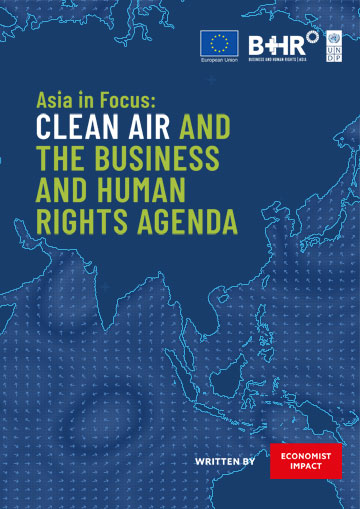 Asia in Focus:
Clean Air and the Business and Human Rights Agenda begins by examining the
extent of the air pollution challenge in the region. Following this, the report
highlights the major sources of air pollution in Asia and explores the cost
implications for the region’s economies and people. The report then outlines
challenges to formulating air pollution policy and charts mitigation measures
already in place. The report concludes by exploring the link between air pollution
and human rights, and demonstrating how international human rights instruments
enable a rights-based approach to addressing environmental violations. Importantly,
the report outlines how the three-pillared framework of the UNGPs might be applied
to effectively overcome the air pollution challenge.
Asia in Focus:
Clean Air and the Business and Human Rights Agenda begins by examining the
extent of the air pollution challenge in the region. Following this, the report
highlights the major sources of air pollution in Asia and explores the cost
implications for the region’s economies and people. The report then outlines
challenges to formulating air pollution policy and charts mitigation measures
already in place. The report concludes by exploring the link between air pollution
and human rights, and demonstrating how international human rights instruments
enable a rights-based approach to addressing environmental violations. Importantly,
the report outlines how the three-pillared framework of the UNGPs might be applied
to effectively overcome the air pollution challenge.
Key findings
The problem of air pollution is particularly severe in the rapidly growing urban centres of Asia. Mounting scientific evidence has brought the magnitude of the air pollution problem into focus along with the long-term economic and health consequences of prolonged exposure to unhealthy air. Asia is disproportionately affected, with South and East Asia home to 49 of the 50 most polluted cities worldwide.4
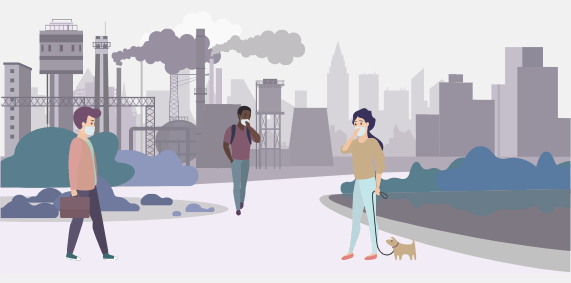
Vulnerable groups disproportionately bear the costs of air pollution. The global economic and public health cost of air pollutants is estimated to be US$2.9trn annually or 3.3% of global GDP (2018).5 However, the impacts of air pollution are unevenly distributed. This holds true for both low-income and high-income countries. Informal economy workers, Indigenous Peoples, women and low-income families are exposed to far greater levels of pollutants, than other groups.
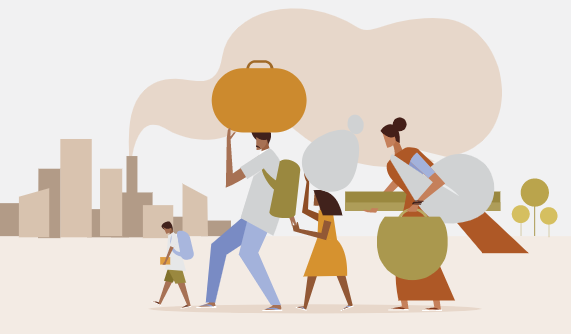
The health impacts of air pollution put future generations at risk. Air pollution can have significant consequences for maternal and neonatal health, adversely affecting fertility, increasing the risk of preterm births and leading to a higher incidence of infant and maternal mortality, birth defects and breast cancer. Falling birth rates could lead to a reduction in the labour force in the coming years, with knock-on effects for future economic growth.

Health impacts of air pollution on the economy. Labour productivity can be adversely affected by air pollution as rising incidences of air pollution-related illnesses lead to increased absenteeism. Poor air quality has proven impacts too, on agricultural production. Consumer-facing businesses report substantially less revenue as customers stay indoors when air quality is poor. The most sought-after workers tend to shun cities and countries where air pollution is high.
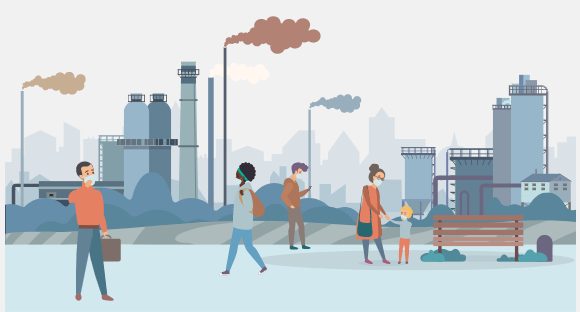
The lack of uniform regulatory frameworks and standardised data contributes to the challenge of addressing air pollution in Asia. The problem of inconsistency in regulatory frameworks among Asian countries is a key obstacle to collaboration in the region. Additionally, the lack of standardised data makes monitoring air pollution more complex and expensive.
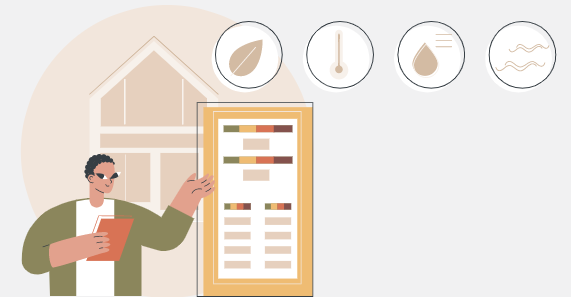
Measures to control air pollution in Asia, though underway, still have more to achieve. Regulatory interventions are showing promise, such as government-mandated monitoring of air quality and emissions standards, and the introduction of more stringent enforcement mechanisms. Positive results are found when businesses align operations with industry best practices and increase awareness of environment-friendly policies among members of the general public and local business communities.
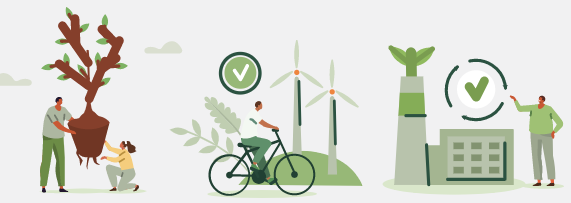
Key recommendations

Clean air must be recognised as a basic human right and priority policy objective. Classifying clean air as a human right changes the perspective with which governments and civil society treat this issue. Rooting clean air policy in human rights gives greater urgency to actions that might mitigate air pollution and generates additional impetus for civil society to demand remedies in courts of law.6 However, while air pollution litigation is on the rise, there are few States in Asia that recognise the right to clean air.
82%
In Asia, 82% of total urban ambient air pollution resulting from PM2.5 originates from man-made sources such as fossil fuel burning (for electricity generation and transport fuels), agricultural burning, waste burning and industrial operations.

Businesses must work to prevent, mitigate and remedy air-pollution-related impacts resulting from their business operations. Businesses have a responsibility to respect human rights, irrespective of their size, location or industry. In Asia, 82% of total urban ambient air pollution resulting from PM2.5 originates from man-made sources such as fossil fuel burning (for electricity generation and transport fuels), agricultural burning, waste burning and industrial operations. It is critical for businesses to understand any adverse impacts of their operations and take steps to mitigate air pollution resulting both directly and indirectly from their operations. Business strategies need to be designed considering any potential adverse impacts on the environment and human rights. Businesses should ensure they conduct due diligence to better understand the human rights risks they pose through the air pollution emissions of their operations and supply chains.

The challenge of air pollution can be addressed through focused State interventions using the UNGPs as a framework. The solutions to curbing air pollution are well-understood, though measures are difficult to coordinate in practice. The UNGPs can help by providing a framework for enabling State action to address air pollution-related human rights impacts. States should implement laws to monitor air quality and its impact on health, and develop laws and regulations to improve air quality ensuring adequate compliance monitoring and enforcement mechanisms. States should also collaborate with different stakeholders in developing solutions to air pollution, educate businesses and civil society to bring about behavioural change and devise incentives and disincentives to promote more sustainable actions. Lastly, States should ensure adequate access to remedies for affected populations.
What are the major sources of air pollution in Asia? What can the State and business community do to limit air pollution? Find out in this video.

References
X1 https://www.ccacoalition.org/en/content/air-pollution-measures-asia-and-pacific
3 For the full list of UNGPs, see > https://www.ohchr.org/sites/default/files/documents/publications/guidingprinciplesbusinesshr_en.pdf
5 Greenpeace Southeast Asia and Centre for Research on Energy and Clean Air
6 https://www.ncbi.nlm.nih.gov/pmc/articles/PMC6923778/#B3
8 https://twitter.com/hp_tourism/status/1246017228274728960
10 https://www.who.int/news/item/04-04-2022-billions-of-people-still-breathe-unhealthy-air-new-who-data
11 https://www.ccacoalition.org/en/content/air-pollution-measures-asia-and-pacific
12 https://timesofindia.indiatimes.com/india/india-third-most-polluted-country-delhi-most-polluted-capital-report/articleshow/81537532
world-air-quality-report-2020-en-pdf
(2020 Report-English -
page 4, section on Executive summary) More recent data is available from the same source but was
released after the report went into production.
13 US AQI >100 https://www.airnow.gov/aqi/aqi-basics/#:~:text=Think%20of%20the%20AQI%20as,300%20represents%20hazardous%20air%20quality
world-air-quality-report-2020-en-pdf
(2020 Report-English -
page 4, section on Executive summary) More recent data is available from the same source but was
released after the report went into production.
14 https://timesofindia.indiatimes.com/india/india-third-most-polluted-country-delhi-most-polluted-capital-report/articleshow/81537532
<
world-air-quality-report-2020-en-pdf
(2020 Report-English
- page 4, section on Executive summary) More recent data is available from the same source but was
released after the report went into production.
15 https://aqli.epic.uchicago.edu/pollution-facts/
16 https://pubmed.ncbi.nlm.nih.gov/33735795/
17 https://www.stateofglobalair.org/
18 https://www.iarc.who.int/wp-content/uploads/2018/07/pr221_E.pdf
22 https://ourworldindata.org/outdoor-air-pollution
25 https://energyandcleanair.org/publications/costs-of-air-pollution-from-fossil-fuels/
26 https://www.ccacoalition.org/en/content/air-pollution-measures-asia-and-pacific
27 https://www.who.int/news-room/fact-sheets/detail/ambient-(outdoor)-air-quality-and-health
28 https://www.who.int/news-room/fact-sheets/detail/ambient-(outdoor)-air-quality-and-health
29 "Air quality guidelines (AQGs) released by the WHO provide recommendations on air quality levels as well as interim targets for six key air pollutants. These are based on the extensive scientific evidence currently available; the guidelines identify the levels of air quality necessary to protect public health worldwide. The AQGs also serve as a reference for assessing if, and by how much, the exposure of a population exceeds levels at which it might cause health concerns. They cover some of the most monitored pollutants critical for health, for which evidence on health effects from exposure has advanced the most in the past 15 years.” https://www.who.int/news-room/questions-and-answers/item/who-global-air-quality-guidelines
30 https://www.iqair.com/blog/air-quality/2021a-WHO-air-quality-guidelines
31 https://www.sciencedirect.com/science/article/pii/S1352231015303320#appsec1
32 https://www.sciencedirect.com/science/article/pii/S0048969720336111
33 https://www.sciencedirect.com/science/article/pii/S0048969720336111
34 https://www.ncbi.nlm.nih.gov/pmc/articles/PMC6923778/
35 https://www.ncbi.nlm.nih.gov/pmc/articles/PMC6923778/#B3
36 https://undocs.org/A/HRC/RES/48/13
37 United Nations, General Assembly, The human right to a clean, healthy and sustainable environment, A/76/L.75 (26 July 2022)
38 https://documents-dds-ny.un.org/doc/UNDOC/GEN/G20/202/42/PDF/G2020242.pdf?OpenElement
39 Interview insight - Dr Surya Deva
40 https://undocs.org/en/A/RES/64/292
41 https://news.un.org/en/story/2021/10/1103082
42 https://www.ohchr.org/en/NewsEvents/Pages/DisplayNews.aspx?NewsID=26116&LangID=E#_ftnref2
44 https://ideas4development.org/en/right-water-fundamental-human-right/
47 https://www.ohchr.org/documents/issues/business/a-hrc-17-31_aev.pdf
48 https://www.ohchr.org/documents/issues/business/a-hrc-17-31_aev.pdf
49 https://www.adb.org/sites/default/files/publication/659631/climate-litigation-asia-pacific.pdf
53 https://discovery.ucl.ac.uk/id/eprint/894/1/Millennium_rvw_final_october.pdf
54 https://tcc-gsr.com/wp-content/uploads/2021/06/1.3-Asia-Regional-Overview.pdf
55 Calculations by Economist Impact, based on data from https://data.adb.org/dataset/asian-transport-outlook-database (See Asia Transport Outlook Database – Excel file name > ‘National air pollution and health’, Sheet name> ‘APH-VAP-031’
56 https://www.channelnewsasia.com/world/explainer-power-impact-climate-change-1339031
58 https://www.stateofglobalair.org/data/#/air/plot
59 https://www.stateofglobalair.org/data/#/air/plot
61 https://blogs.adb.org/blog/crystal-clear-asia-s-cities-are-finding-innovative-ways-clean-their-skies
62 Figures are estimates from modelling exercises. Scientific studies that use computer models do not give results with absolute certainty. Instead a range is provided (known as an 'interval'). The ‘confidence range’ is the range that is most likely to contain the true value. A 95% confidence interval means that with 95% probability, reality is somewhere inside the confidence interval, and a 5% chance it is outside the interval (either higher or lower than the range of numbers in the range). The value with the highest probability to be the true value is called the central estimate. It is somewhere inside the confidence interval. The bounds of the confidence interval are called the low and the high estimate.
64 These figures are central estimates. See footnote 60 for a definition of central estimates.
66 https://www.unescap.org/sites/default/files/The%20Economics%20of%20Climate%20Change%20%20in%20the%20Asia-Pacific%20region.pdf (Section on Highlights, page v)
67 https://mitsloan.mit.edu/ideas-made-to-matter/psychological-economic-and-social-costs-air-pollution
68 https://mitsloan.mit.edu/ideas-made-to-matter/psychological-economic-and-social-costs-air-pollution
70 https://www.unep.org/news-and-stories/story/why-legislation-needed-curb-air-pollution
71 https://www.unep.org/news-and-stories/story/five-reasons-you-should-care-about-air-pollution
72 https://bmcpublichealth.biomedcentral.com/articles/10.1186/s12889-018-6025-1
73 https://www.stateofglobalair.org/health/global#Millions-deaths
74 https://aqli.epic.uchicago.edu/the-index/
75 https://aqli.epic.uchicago.edu/the-index/
79 Ground level ozone is a pollutant formed as a result of chemical reactions between oxides of nitrogen and volatile organic compounds in the presence of sunlight. These chemicals are emitted from industrial plants, electric utilities, vehicle exhaust etc.
81 https://www.sei.org/featured/5-ways-reducing-pollution-can-improve-equality-for-women/
82 https://www.ft.com/content/ee08d61d-4c98-4398-9971-93036d67e91e
83 https://impact.economist.com/perspectives/sites/default/files/resettingtheagenda.pdf
87 https://www.un.org/en/observances/biological-diversity-day
88 http://www.equilibriumconsultants.com/upload/document/airpollutionandbiodi4f9.pdf
89 https://www.ilo.org/asia/media-centre/news/WCMS_627585/lang--en/index.htm
92 https://academic.oup.com/cardiovascres/article/116/14/2247/5940460
93 https://www.sciencedirect.com/science/article/pii/S0160412016305992
94 https://asiapacific.unfpa.org/en/news/rights-indigenous-peoples-must-be-protected-and-respected
95 https://www.worldbank.org/en/topic/indigenouspeoples#1
96 https://www.worldbank.org/en/topic/indigenouspeoples#1
98 https://www.unep.org/news-and-stories/story/five-reasons-you-should-care-about-air-pollution
99 https://ourworldindata.org/grapher/pm25-exposure-gdp
100 Interview insight from Prarthana Borah
102 https://www.ccacoalition.org/en/content/air-pollution-measures-asia-and-pacific
103 https://cil.nus.edu.sg/wp-content/uploads/2020/05/2013-Updated-APMS-1.pdf
104 https://www.eria.org/ERIA-DP-2015-82.pdf
105 https://www.greenpeace.org/southeastasia/press/3239/a-haze-free-asean-by-2020-are-we-there-yet/
106 https://theicct.org/sites/default/files/publications/Indonesia-sootfree-CBA-02182020.pdf
109 https://www.iqair.com/world-most-polluted-cities/world-air-quality-report-2020-en.pdf
110 https://www.unep.org/news-and-stories/story/air-pollution-choking-bangkok-solution-reach
112 https://www.iqair.com/world-most-polluted-cities/world-air-quality-report-2020-en.pdf
113 https://www.mdpi.com/2032-6653/12/1/2/pdf
114 https://www.iqair.com/world-most-polluted-cities/world-air-quality-report-2020-en.pdf
116 https://theicct.org/sites/default/files/publications/India%20BS%20VI%20Policy%20Update%20vF.pdf
117 https://www.pmuy.gov.in/about
119 https://www.sciencedirect.com/science/article/pii/S2590162120300368
120 https://www.iqair.com/world-most-polluted-cities/world-air-quality-report-2020-en.pdf
122 https://www.kasa.gov.my/roadmap/Roadmap_KASA_2020-2030-en.pdf
124 https://www.pna.gov.ph/articles/1159659
125 https://changing-transport.org/modernizing-public-transport-in-the-philippines/
126 https://www.officialgazette.gov.ph/2016/01/28/govt-supports-road-sharing/
128 https://bmcpublichealth.biomedcentral.com/articles/10.1186/1471-2458-10-300
133 https://energyandcleanair.org/china-14th-five-year-plan-carbon-neutrality/
135 http://english.www.gov.cn/news/topnews/202109/09/content_WS6139a111c6d0df57f98dfeec.html
136 https://aqli.epic.uchicago.edu/country-spotlight/china/
140 https://epic.uchicago.in/wp-content/uploads/2019/10/ETS_INDIA_ResearchSummaryFinal-.pdf
142 https://epic.uchicago.in/wp-content/uploads/2019/10/ETS_INDIA_ResearchSummaryFinal-.pdf
144 https://www.tandfonline.com/doi/abs/10.1080/09644016.2017.1338213?journalCode=fenp20
145 https://smartcities.gov.in/climatesmart_cities
146 https://www.niua.org/csc/assets/pdf/key-documents/phase-2/CSCAF-2.0-Brochure_24042020.pdf
147 For the full list of UNGPs, see > https://www.ohchr.org/sites/default/files/documents/publications/guidingprinciplesbusinesshr_en.pdf
150 Garton, Kelly, Thow, Anne Marie & Swinburn, Boyd. (2020). International Trade and Investment Agreements as Barriers to Food Environment Regulation for Public Health Nutrition: A Realist Review. Journal of Health Policy and Management.
151 For the full list of UNGPs, see > https://www.ohchr.org/sites/default/files/documents/publications/guidingprinciplesbusinesshr_en.pdf
152 https://unfccc.int/sites/default/files/resource/Considerations%20regarding%20vulnerable.pdf
153 https://www.sei.org/featured/5-ways-reducing-pollution-can-improve-equality-for-women/
155 Not exhaustive





